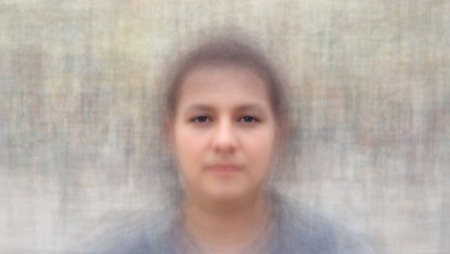Die Anderen sind wir / the others are we / gli altri siamo noi raises the question of what remains if the individual visual characteristics of people are generalized, and as a connecting link between them, remains only the place where they temporarily or permanently dwell.
Die Anderen sind wir / the others are we / gli altri siamo noi are video portraits of the average faces of people in Ragusa (IT), Wakefield (UK), Schweinfurt (D) and Frankfurt a.M. (D). In each of the four videos, the faces of 40 to 60 people of different sex, age, ethnic and cultural backgrounds are combined into a single portrait – the average face of the city.
This is neither supposed to be a scientific approach nor the attempt to identify regional differences. The work rather seeks the connecting, the universal. Although the four videos are composed of very different individual faces - each half female and male - they ultimately look very similar. One has the feeling that they might be siblings.
The videos are just one level of the work. They are the goal and result, yet the process of their development has its own quality as a participatory performance in public space. I was around in the four cities with camera, chair and lights and asked people on the street to have their video portrait taken. 40 people participated in Ragusa, Sicily, 60 in Wakefield, Northern England and 50 each in Schweinfurt and Frankfurt. Each person sat for 90 seconds on a chair with a headrest, quietly looking straight in the camera while I remained similarely motionless behind the camera, looking at the image of the person in the camera's display. Although it initially gives the impression that these two people are looking at each other, they both look at the camera, which makes makes the camera a technical mediator between those people – an connotation that can be understood as comment on the modern media world.
The moment of two people remaining in mutual silence in public space has both performative and sculptural qualities and evokes further associations. For example, the technical set-up of a chair with a headrest, light and camera, and the black suit refer to the early days of photography when an exposure lasted for several seconds, meaning that more passing time was taken in a picture than today. If the photographed person moved during the exposure – which is almost inevitable with long exposure times – the portrait was blurred. Blur can also be found in the video portraits, whereas it results from the superposition of the many faces. The only sharp spots in the videos are the eyes that uninterruptedly focus the viewer
The backdrop of the videos consists of accumulation of city views. Each single recording was taken at a different site in the city. By superimposing the individual films, the city views are condensed into an abstract-looking structure of color, light and movement. The soundtrack of the four videos consists of recordings of the soundscape of the respective city.





